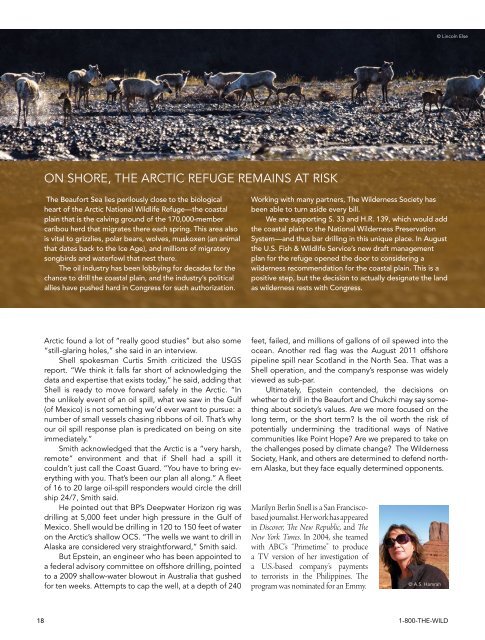Download Document - The Wilderness Society
Download Document - The Wilderness Society
Download Document - The Wilderness Society
Create successful ePaper yourself
Turn your PDF publications into a flip-book with our unique Google optimized e-Paper software.
ON SHORE, THE ARCTIC REFUGE REMAINS AT RISK<br />
<strong>The</strong> Beaufort Sea lies perilously close to the biological<br />
heart of the Arctic National Wildlife Refuge—the coastal<br />
plain that is the calving ground of the 170,000-member<br />
caribou herd that migrates there each spring. This area also<br />
is vital to grizzlies, polar bears, wolves, muskoxen (an animal<br />
that dates back to the Ice Age), and millions of migratory<br />
songbirds and waterfowl that nest there.<br />
<strong>The</strong> oil industry has been lobbying for decades for the<br />
chance to drill the coastal plain, and the industry’s political<br />
allies have pushed hard in Congress for such authorization.<br />
Arctic found a lot of “really good studies” but also some<br />
“still-glaring holes,” she said in an interview.<br />
Shell spokesman Curtis Smith criticized the USGS<br />
report. “We think it falls far short of acknowledging the<br />
data and expertise that exists today,” he said, adding that<br />
Shell is ready to move forward safely in the Arctic. “In<br />
the unlikely event of an oil spill, what we saw in the Gulf<br />
(of Mexico) is not something we’d ever want to pursue: a<br />
number of small vessels chasing ribbons of oil. That’s why<br />
our oil spill response plan is predicated on being on site<br />
immediately.”<br />
Smith acknowledged that the Arctic is a “very harsh,<br />
remote” environment and that if Shell had a spill it<br />
couldn’t just call the Coast Guard. “You have to bring everything<br />
with you. That’s been our plan all along.” A fleet<br />
of 16 to 20 large oil-spill responders would circle the drill<br />
ship 24/7, Smith said.<br />
He pointed out that BP’s Deepwater Horizon rig was<br />
drilling at 5,000 feet under high pressure in the Gulf of<br />
Mexico. Shell would be drilling in 120 to 150 feet of water<br />
on the Arctic’s shallow OCS. “<strong>The</strong> wells we want to drill in<br />
Alaska are considered very straightforward,” Smith said.<br />
But Epstein, an engineer who has been appointed to<br />
a federal advisory committee on offshore drilling, pointed<br />
to a 2009 shallow-water blowout in Australia that gushed<br />
for ten weeks. Attempts to cap the well, at a depth of 240<br />
Working with many partners, <strong>The</strong> <strong>Wilderness</strong> <strong>Society</strong> has<br />
been able to turn aside every bill.<br />
We are supporting S. 33 and H.R. 139, which would add<br />
the coastal plain to the National <strong>Wilderness</strong> Preservation<br />
System—and thus bar drilling in this unique place. In August<br />
the U.S. Fish & Wildlife Service’s new draft management<br />
plan for the refuge opened the door to considering a<br />
wilderness recommendation for the coastal plain. This is a<br />
positive step, but the decision to actually designate the land<br />
as wilderness rests with Congress.<br />
feet, failed, and millions of gallons of oil spewed into the<br />
ocean. Another red flag was the August 2011 offshore<br />
pipeline spill near Scotland in the North Sea. That was a<br />
Shell operation, and the company’s response was widely<br />
viewed as sub-par.<br />
Ultimately, Epstein contended, the decisions on<br />
whether to drill in the Beaufort and Chukchi may say something<br />
about society’s values. Are we more focused on the<br />
long term, or the short term? Is the oil worth the risk of<br />
potentially undermining the traditional ways of Native<br />
communities like Point Hope? Are we prepared to take on<br />
the challenges posed by climate change? <strong>The</strong> <strong>Wilderness</strong><br />
<strong>Society</strong>, Hank, and others are determined to defend northern<br />
Alaska, but they face equally determined opponents.<br />
Marilyn Berlin Snell is a San Franciscobased<br />
journalist. Her work has appeared<br />
in Discover, <strong>The</strong> New Republic, and <strong>The</strong><br />
New York Times. In 2004, she teamed<br />
with ABC’s “Primetime” to produce<br />
a TV version of her investigation of<br />
a U.S.-based company’s payments<br />
to terrorists in the Philippines. <strong>The</strong><br />
program was nominated for an Emmy.<br />
© A.S. Hamrah<br />
18 1-800-THE-WILD<br />
© Lincoln Else


